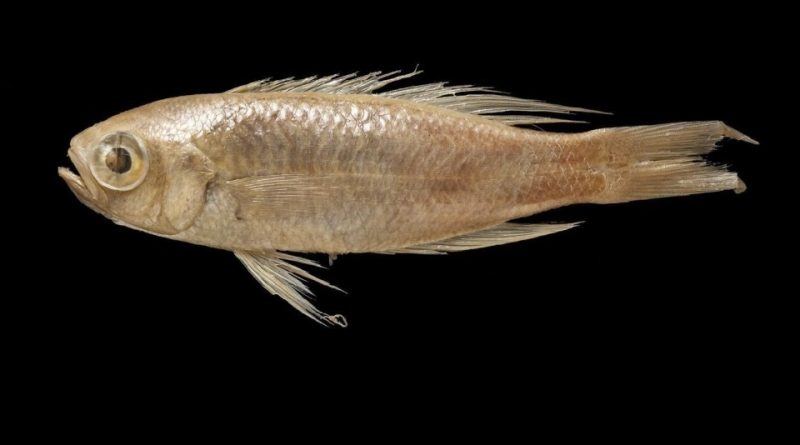Callanthias ruber
Callanthias ruber
The Parrot seaperch (Callanthias ruber Rafinesque, 1810) is a marine fish belonging to the Callanthidae family.
Systematic –
From a systematic point of view it belongs to:
Eukaryota domain,
Kingdom Animalia,
Subkingdom Eumetazoa Bilateria,
Phylum Chordata,
Subphylum Vertebrata,
Superclass Gnathostomata,
Class Actinopterygii,
Subclass Osteichthyes,
Superorder Acanthopterygii,
Order Perciformes,
Suborder Percoidei,
Callanthidae family,
Genus Callanthias,
Species C. ruber.
The term is basionym:
– Lepimphis ruber Rafinesque, 1810.
The terms are synonymous:
– Anthias buphthalmos Bonaparte, 1833;
– Bodianus peloritanus Cocco, 1829;
– Callanthias paradisaeus Lowe, 1839;
– Callanthias paradiseus Lowe, 1839;
– Callanthias peloritanus (Cocco, 1829);
– Lepimphis ruber Rafinesque, 1810.
Geographic Distribution and Habitat –
The Callanthias ruber is a fish that we find in the eastern Atlantic Ocean from the Channel, where it is however rare, north to Mauritania and south including the Azores, Madeira and Canary Islands as well as the entire Mediterranean Sea.
On the Italian coasts it is quite rare while in the Strait of Messina it happens to be caught quite often with lines used for fishing for other deep-sea species. However, it is a sporadic species and not common anywhere.
Its marine habitat is that of rocky areas between 200 and 500 m, generally on hard bottoms but also on muddy bottoms.
Description –
The Callanthias ruber is a fish that is recognized by its elongated body, not very tall, slightly compressed laterally and covered with large spiny scales, which are very rough to the touch. The dimensions rarely exceed 60 cm in length but, as a rule, it is much smaller.
Dorsally it has an intense red color, shaded with lilac up to the lateral line. The sides are much lighter, going from pink to mother-of-pearl blue, especially ventrally. The fins are canary-yellow with spots on the dorsal and red stripes on the caudal. The ventrals are pale yellow. The cheeks are golden with blue highlights. The iris is pinkish-silvery.
The lateral line begins at the upper corner of the operculum and rises towards the upper margin of the dorsum to follow its profile and ends abruptly at the beginning of the caudal peduncle.
The head is covered with scales and has a preoperculum with a smooth margin and an operculum with two flat spines at the upper corner. The eye is large and circular.
The mouth is small, oblique with thin needle-like teeth and the largest caniniform ones. Other small teeth are present on the vomer and palatines.
The nostrils are spaced apart and are not tubular.
The dorsal fin, composed of 11 spiny and 10 soft rays, is unique and grows in height starting from the 1st ray up to the 15th, which is the longest of all; the last six rays decrease abruptly.
The anal one, composed of 3 spiny rays and 10 soft rays, is inserted in correspondence with the last spiny rays of the dorsal; it grows steadily from the first to the last ray and ends at the same height as the end of the ridge.
The caudal is very long, forked and with a rounded internal margin and the external rays ending in thin and very long filaments, of which the upper one is almost always longer than the lower one.
The pectorals and ventrals are rather short.
Biology –
The Callanthias ruber is a fish of unknown reproduction, also due to the depths in which it lives.
However, it is known that it is oviparous, perhaps hermaphroditic and fertilization is external.
Ecological Role –
Callanthias ruber feeds on crustaceans and small fish.
It is occasionally fished with trawl nets or lines at considerable depth.
Its meat is edible, but not much appreciated due to the abundance of thorns.
Guido Bissanti
Sources
– Wikipedia, the free encyclopedia.
– GBIF, the Global Biodiversity Information Facility.
– Louisy P., 2016. Guide to the identification of marine fishes of Europe and the Mediterranean. Il Castello Editore, Milan.
– Nikiforos G., 2008. Fauna of the Mediterranean. Giunti Editore, Florence.
Photo source:
– https://data.nhm.ac.uk/media/a1fb4e20-a9bb-4f30-b822-fe9b1d301efc
– http://photos.gbif.fr/mnhn_nice/aquarelles_animaux_marins_et_plantes/2005-0-828.jpg


